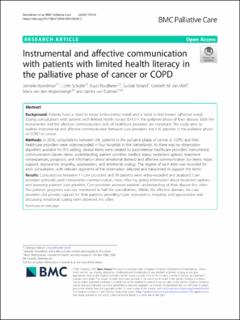| dc.contributor.author | Noordman, Janneke | |
| dc.contributor.author | Schulze, Lotte | |
| dc.contributor.author | Roodbeen, Ruud | |
| dc.contributor.author | Boland, Gudule | |
| dc.contributor.author | Van Vliet, Liesbeth M. | |
| dc.contributor.author | van den Muijsenbergh, Maria | |
| dc.contributor.author | van Dulmen, Sandra | |
| dc.date.accessioned | 2021-03-25T09:58:29Z | |
| dc.date.available | 2021-03-25T09:58:29Z | |
| dc.date.created | 2021-02-24T15:25:53Z | |
| dc.date.issued | 2020 | |
| dc.identifier.citation | Noordman, J., Schulze, L., Roodbeen, R., Boland, G., van Vliet, L. M., van den Muijsenbergh, M. & van Dulmen, S. (2020). Instrumental and affective communication with patients with limited health literacy in the palliative phase of cancer or COPD. BMC Palliative Care, 19, 152. | en_US |
| dc.identifier.issn | 1472-684X | |
| dc.identifier.uri | https://hdl.handle.net/11250/2735446 | |
| dc.description.abstract | Background: Patients have a ‘need to know’ (instrumental need) and a ‘need to feel known’ (affective need). During consultations with patients with limited health literacy (LHL) in the palliative phase of their disease, both the instrumental and the affective communication skills of healthcare providers are important. The study aims to explore instrumental and affective communication between care providers and LHL patients in the palliative phase of COPD or cancer.
Methods: In 2018, consultations between LHL patients in the palliative phase of cancer or COPD and their healthcare providers were video-recorded in four hospitals in the Netherlands. As there was no observation algorithm available for this setting, several items were created to parameterize healthcare providers’ instrumental communication (seven items: understanding, patient priorities, medical status, treatment options, treatment consequences, prognosis, and information about emotional distress) and affective communication (six items: hope, support, reassurance, empathy, appreciation, and emotional coping). The degree of each item was recorded for each consultation, with relevant segments of the observation selected and transcribed to support the items.
Results: Consultations between 17 care providers and 39 patients were video-recorded and analyzed. Care providers primarily used instrumental communication, most often by giving information about treatment options and assessing patients’ care priorities. Care providers assessed patients’ understanding of their disease less often. The patients’ prognosis was not mentioned in half the consultations. Within the affective domain, the care providers did provide support for their patients; providing hope, reassurance, empathy, and appreciation and discussing emotional coping were observed less often.
Conclusions: Care providers used mostly instrumental communication, especially treatment information, in consultations with LHL patients in the palliative phase of cancer or COPD. Most care providers did not check if the patient understood the information, which is rather crucial, especially given patients’ limited level of health literacy. Healthcare providers did provide support for patients, but other expressions of affective communication by care providers were less common. To adapt the communication to LHL patients in palliative care, care providers could be less wordy and reduce the amount of information, use ‘teach-back’ techniques and pay more attention to affective communication. | en_US |
| dc.language.iso | eng | en_US |
| dc.rights | Navngivelse 4.0 Internasjonal | * |
| dc.rights.uri | http://creativecommons.org/licenses/by/4.0/deed.no | * |
| dc.title | Instrumental and affective communication with patients with limited health literacy in the palliative phase of cancer or COPD | en_US |
| dc.type | Peer reviewed | en_US |
| dc.type | Journal article | en_US |
| dc.description.version | publishedVersion | en_US |
| dc.rights.holder | © The Author(s), 2020. | en_US |
| dc.source.volume | 19 | en_US |
| dc.source.journal | BMC Palliative Care | en_US |
| dc.identifier.doi | https://doi.org/10.1186/s12904-020-00658-2 | |
| dc.identifier.cristin | 1893297 | |
| dc.source.articlenumber | 152 | en_US |
| cristin.ispublished | true | |
| cristin.fulltext | original | |
| cristin.qualitycode | 1 | |

